As a connecting element between floors, staircases fulfill their main purpose. Structurally, they are of different types, types, they are arranged in different ways and from different materials. Regarding suburban individual construction, there has long been a tendency to build houses and cottages in two or three floors, often there is also a basement level.
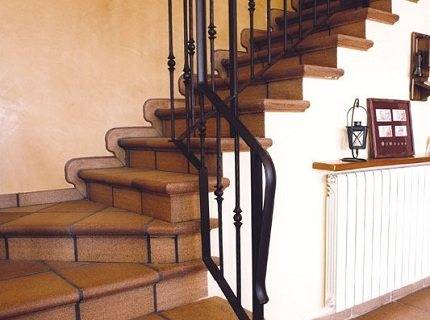
In this case, the staircase, in addition to the utilitarian function, also performs an aesthetic task, and can also be an element on which the entire architectural and design concept is formed. Beautiful staircases ennoble the home. In addition, tiles for stairs in the house allow you to embody all ideas and design solutions.
The use of ceramic tiles in staircase decoration
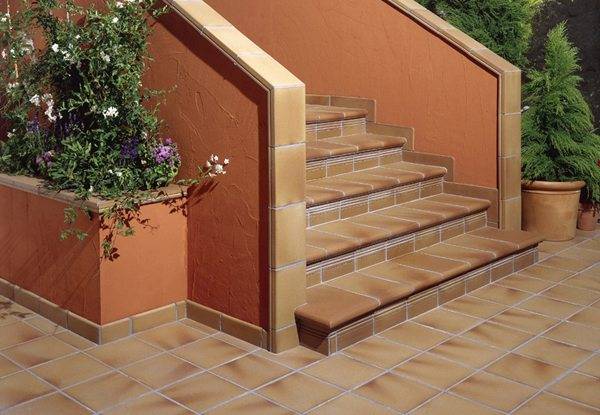
It should be noted that tiling of stairs has been used quite successfully for more than a dozen years. But the emergence of new modern materials designed specifically for stairs makes it possible to forget about the various tricks and know-how of masters who had little choice.
At the moment, when choosing a tile, you can take into account almost all factors and choose a material with the most suitable characteristics and that allows you to fully match the interior solution, the owner's taste, etc.
For finishing the stairs, materials are used that can be divided into two groups - according to quality characteristics and type, which, as a rule, dictates the method of installation.
Which tile to choose
A certain number of requirements are imposed on the materials used for these structures, and the obligation to comply with some is dictated by safety measures and the effectiveness of the use of materials.
Anti-slip effect
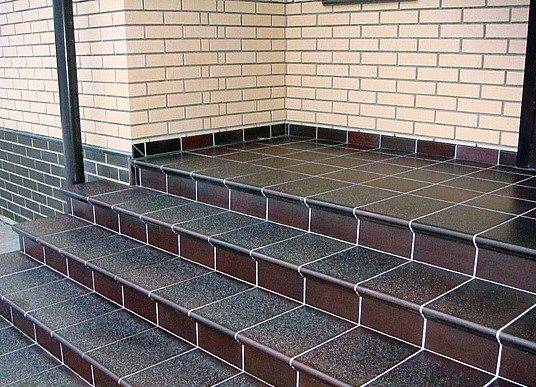
Anti-slip tiles for stairs on the street are necessary, and this requirement should be taken very seriously: the safety of using staircases depends on it, and, consequently, the health of people using them.
It is recommended to use a material with these characteristics for interior stairs as well. For example, tiles for stairs to the second floor should have similar characteristics, especially if, due to a lack of space, it has a larger slope angle. That is why the steps are often made of tiles with special slots or projections.
Wear resistance and strength of ceramic products
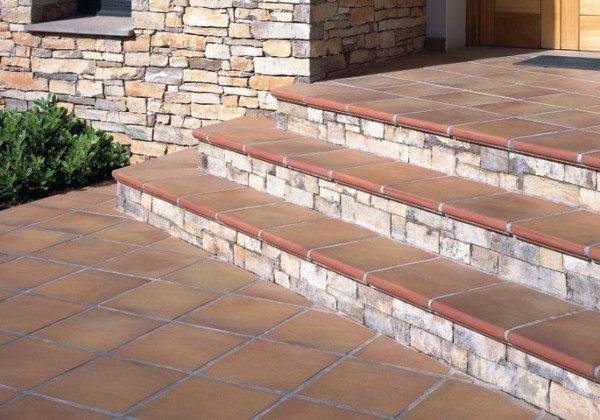
The next characteristic that has a significant impact on the choice - wear resistance, given the rather intensive use. Also, increased requirements are imposed on strength and ability to withstand loads. The strength of a tile can be judged even by its appearance - the larger its area and less thickness, the less durable the product is.
Frost resistance
For materials used for outdoor stairs, such as a porch, the indicator will be important frost resistance... One of the most popular options is clinker tiles for outdoor stairs, in which all the performance indicators are optimal for these conditions.
In addition, clinker resists various abrasive influences, for example, sand on outdoor shoes.
Attention! Sometimes an internal staircase made of tiles can be made of clinker, but often this choice is dictated by the interior design, and not by the special characteristics of the material.
The main types of tiles used for staircase structures
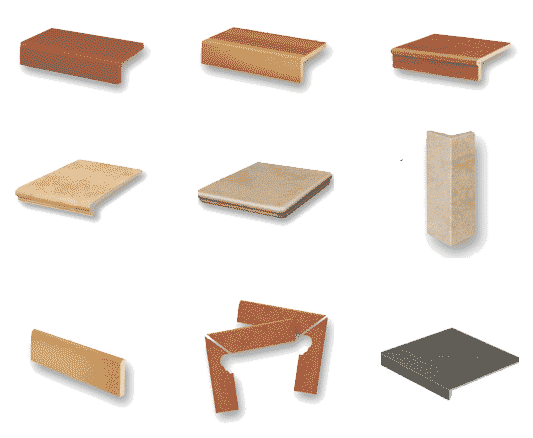
Most often, the tiles on the stairs are chosen among the following varieties:
- ceramic floor tiles;
- special ceramic tiles, consisting of elements and intended for finishing stairs;
- clinker tiles;
- porcelain stoneware, etc.
If you plan to do the work yourself, you should pay attention to the kits consisting of step tiles, risers, plinths; in some versions, there may also be a special cornice - a ceramic corner for steps.
For example, stair tiles are supplied corrugated surface for greater stability when walking on it, it can also be a decorative element of the material, it is placed on the edges or on the corner cornice.
In general, in the finishing of stairs, special attention should be paid to the edges, since they account for a significant part of the total load, therefore they must be strong and as even and correctly laid as possible.
Methods for laying tiles on stairs
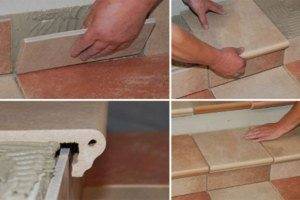
- Laying treads or top tiles with a slight overhang equal to the thickness of the riser. This method, being quite simple in execution, is suitable for structures with low operating intensity. Otherwise, the edge, experiencing constant loads, collapses very quickly. Suitable only for glazed types, and the execution technology is as follows:
- the risers are the first to fit;
- tread tiles are installed on them, that is, the steps themselves;
- work is done "flush", but not end-to-end;
- grouting of the formed seam.
- Laying ceramic tiles for stairs with a corrugated edgewhich, thanks to the notches, guarantee greater safety, and are carried out with an overhang, which is also equal to the thickness of the riser tile;
Advice. This method is also relevant for corrugated options with a rounded or otherwise processed front edge.
- The following types of materials are widely used:
- products with sides or "shelf" that hang over the riser, as an alternative to corrugated tiles;
- The same purpose is served by the profiles, which clearly define the edges of the steps, which makes walking safe, and the external aesthetic appearance of the stairs more correct and attractive.
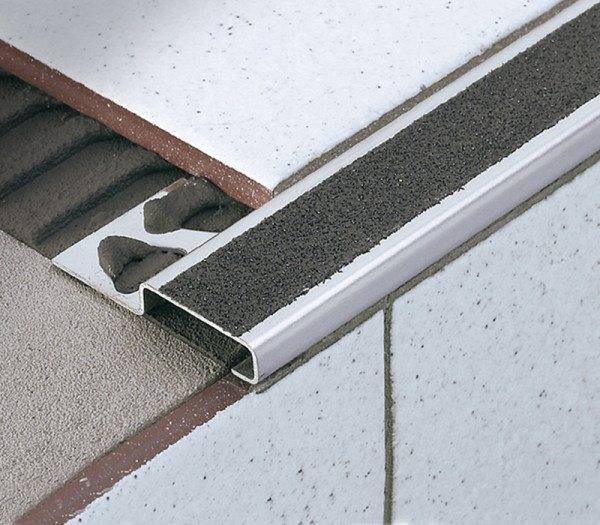
The profiles used are:
- metal;
- plastic;
- are produced in different colors or with imitation of a certain structure, for example, wood, marble;
- special pads that are used not only for safety, but also for the safety of stair steps and their finishing.
Pads are stainless or aluminum plates that are attached to the edge with dowels or screws. The PVC top layer is removable.
Can be used on stairs in different situations:
- with insufficient anti-slip characteristics, imparting greater stability when walking;
- for the design of the edges of the steps and ceramic corners (cornices) in the form of rods, strips, corners.
The onlays are easily attached with ceramic adhesives. In most cases, such products are included in the kit and correspond to the general design and colors, although, if necessary, they can be selected and purchased separately.
The ceramic corner is laid with a small gap with the tiles, and it is he who creates the characteristic hanging and rounded edge of the stairs.
How much does it cost to refine a staircase
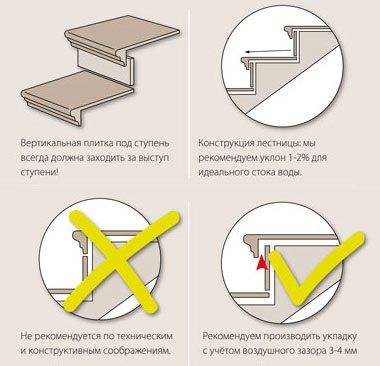
Of course, many work related to construction, repair or decoration in your own home can be done independently, but sometimes for difficult cases, which include the device and finishing of staircase structures, it makes sense to attract professionals.
The cost of laying tiles on the stairs in this case will vary from the total area, the size of the stairs and can range from $ 10-15. up to 35 USD and above for one square meter. It should be noted that the price for laying tiles on a staircase may depend on the quality of the material, the complexity of working with it and the complexity of the structural features of the staircase itself.
Materials and tools for laying tiles on the stairs
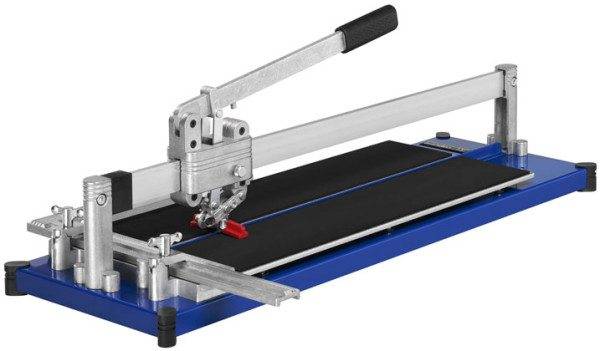
In the event that a decision is made to act independently, it is necessary to stock up on the appropriate inventory for the work and purchase the necessary materials.
You will definitely need:
- tile cutter;
- a drill with a special whisk attachment for preparing an adhesive solution;
- square;
- level;
- smooth, notched and rubber spatula for grouting;
- "Crosses";
- grater for preparing the base;
- a bucket or other container for solution;
- cord;
- sponge and rags.
It is necessary to calculate and purchase materials in advance. You will need:
- ceramic tiles for stairs or other finishing material;
- styling glue;
- grout for joints;
- all decorative and functional elements - corners, profiles, skirting boards.
If it is difficult to independently calculate the required amount of materials necessary for work, and there is no desire to contact a construction company, then this task can be entrusted to the consultant managers of the store or salon where you plan to make a purchase.
How to properly lay tiles on the stairs: the main stages of work
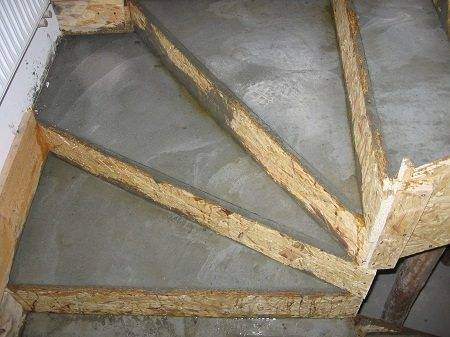
If the technology of laying tiles on the stairs is followed, the result will be a beautiful and reliable structure that will serve for quite a long time without the need for repairs or a complete replacement of the finish. To do this, you will have to adhere to a certain work plan, which looks like this.
- Preparatory work:
- before starting work, it is necessary to prepare the surface, clean it, if necessary, treat it with a trowel, remove the dirt along with the remnants of the mortar. Make a markup, draw up a plan for laying tiles, joints, seams, etc.;
- think over the location of the picture, if any;
- mark the places where the cut pieces will fit, as well as their number;
- prepare an adhesive solution, while the instructions for it must be strictly followed.
- This is followed directly by the stage of laying the tiles. For a more reliable joining, it is recommended to first perform horizontal surfaces, that is, risers, and then lay tile-steps on them, although some craftsmen prefer to perform these operations in the reverse order.

Conclusion
Carrying out work in a private house or cottage related to finishing stairs, not only allows you to create a beautiful and presentable look for the whole room, but also protects the structure itself for many years. You can watch the types of staircase finishing with tiles in the video in this article (find out also what railings exist for metal stairs).






Throw slippers at me, but I am against concrete stairs in the house. I chose the wrong tile and that's it, consider that fractures are guaranteed to you. You can, of course, afford it if there are no children, but in the future they appear, and rebuilding a staircase is much more difficult than taking it out from scratch. Plus, it is always icy, it is not pleasant to walk on it, if you do a warm floor - separate monetary costs. I think wood is much nicer and more practical.
I support Ivan, concrete stairs have nothing to do in a residential building. they are good only in entrances and on the street. at home it is more comfortable to walk on a wooden staircase, or, in extreme cases, a combined one (metal and wood)